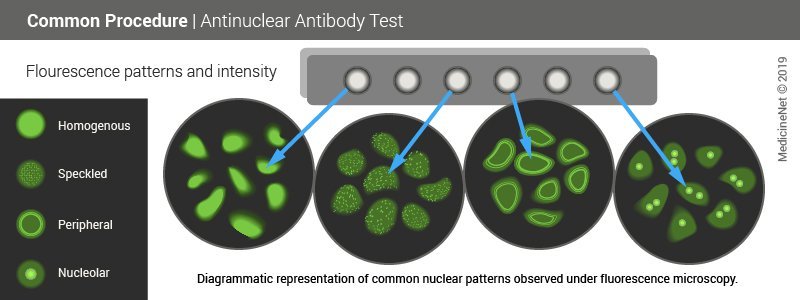Antinuclear Antibody Test
What are antinuclear antibodies?

We normally have antibodies in our blood that repel invaders in our bodies, such as virus and bacteria microbes. Antinuclear antibodies (ANAs) are unusual antibodies, detectable in the blood, that have the capability of binding to certain structures within the nucleus of the cells. The nucleus is the innermost core within the body's cells and contains the DNA, the primary genetic material. ANAs are found in patients whose immune system may be predisposed to cause inflammation against their own body tissues. Antibodies that are directed against one's own tissues are referred to as autoantibodies. The propensity for the immune system to work against its own body is referred to as autoimmunity. ANAs suggest the possible presence of autoimmunity. Therefore, when they are detected in a patient's blood (referred to as a "positive" result), doctors will consider the possibility that an autoimmune illness exists in that patient.
Autoimmune diseases are conditions in which there is a disorder of the immune system characterized by the abnormal production of antibodies (autoantibodies) directed against the tissues of the body. Autoimmune diseases typically feature inflammation of various tissues of the body. Frequently, ANAs are found in patients with a number of different autoimmune diseases, such as systemic lupus erythematosus, Sjögren's syndrome, rheumatoid arthritis, polymyositis, scleroderma, Hashimoto's thyroiditis, juvenile diabetes mellitus, Addison disease, vitiligo, pernicious anemia, glomerulonephritis, and pulmonary fibrosis. ANAs can also be found in patients with conditions that are not considered classic autoimmune diseases, such as chronic infections and cancer.
Who created the ANA test? How do health care professionals perform the procedure?
The ANA test was designed by Dr. George Friou in 1957. The ANA test is performed using a blood sample. An ANA test is performed by testing the blood in the laboratory. The antibodies in the serum of the blood are exposed in the laboratory to cells. It is then determined whether or not antibodies are present that react to various parts of the nucleus of cells. Thus, the term anti-"nuclear" antibody. Fluorescence techniques are frequently used to actually detect the antibodies in the cells, thus ANA testing is sometimes referred to as fluorescent antinuclear antibody test (FANA).
What is the interpretation of the ANA screen result?
The ANA test is a sensitive screening test used to detect autoimmune diseases. Autoimmune diseases feature a misdirected immune system, and each of them has characteristic clinical manifestations that are used to make the precise diagnosis. The interpretation or identification of a positive ANA test does not make a diagnosis. It simply suggests to the doctor to consider the possibility that an autoimmune disease is present.
What non-autoimmune conditions produce ANAs?
ANAs can be produced in patients with infections (virus or bacteria), lung diseases (primary pulmonary fibrosis, pulmonary hypertension), gastrointestinal diseases (ulcerative colitis, Crohn's disease, primary biliary cirrhosis, alcoholic liver disease), hormonal diseases (Hashimoto's autoimmune thyroiditis, Grave's disease), blood diseases (idiopathic thrombocytopenic purpura, hemolytic anemia), cancers (melanoma, breast, lung, kidney, ovarian and others), skin diseases (psoriasis, pemphigus), as well as in the elderly and those people with a family history of rheumatic diseases.
Can medications cause elevated ANAs?
Many medications can sometimes stimulate the production of ANAs, including procainamide (Procan SR), hydralazine (Apresoline), and phenytoin (Dilantin). ANAs that are stimulated by medication are referred to as drug-induced ANAs. This does not necessarily mean that any disease is present when these ANAs are "induced." Sometimes diseases are associated with these ANAs, and they are referred to as drug-induced diseases.
ANAs are defined as having patterns. What does this mean?
ANAs present different "patterns" depending on the staining of the cell nucleus in the laboratory: homogeneous or diffuse pattern; speckled pattern; nucleolar pattern; and peripheral or rim pattern. While these patterns are not specific for any one illness, certain illnesses can more frequently be associated with one pattern or another. The patterns then can sometimes give the doctor further clues as to types of illnesses to look for in evaluating a patient. For example, the nucleolar pattern is more commonly seen in the disease scleroderma. The speckled pattern is seen in many conditions and in people who do not have any autoimmune disease. These patterns are determined by technical experts who routinely interpret the tests.
Are ANAs always associated with illness? What is the normal range?
No. ANAs can be found in approximately 5% of the normal population, usually in low titers (low levels). These people usually have no disease. Titers of 1:80 or lower are less likely to be significant. (ANA titers of less than or equal to 1:40 are considered negative.) Even higher titers are often insignificant in patients over 60 years of age. Ultimately, the ANA result must be interpreted in the specific context of an individual patient's symptoms, underlying medical conditions, and other test results. It may or may not be significant, even if positive, in a given individual.

